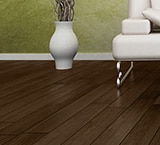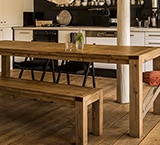Wood laminate flooring and real hardwood flooring have a similar appearance as a completed element of your home, but there are different types of wood and laminate that can be overlooked during the selection process. With so many choices of wood and laminates, what are the best products and materials for you? Consider some of the advantages and disadvantages of each, as well as what works best within your budget.
WOOD LAMINATE FLOORS
Wood laminate flooring installs and wears differently than real wood flooring because these boards are composed of several layers of materials fused together. The inner core layer is usually composed of melamine resin and solid fiber. A photographic applique layer is fused on top, then treated with a tough aluminum oxide finish that affords you excellent wear against scratches, burns, dents and stains. You can choose from an abundance of designs, colors and wood looks, many of which take on the appearance of real woods.
Keep in mind that spills and leaks can damage laminate flooring. And once damaged, it cannot be refinished like real wood this means necessitating a replacement of the damaged planks. Nonetheless, it is often an easy installation for lower cost than most real hardwood.
REAL WOOD FLOORS
Real wood flooring spans several subcategories of its own, including type, formation, size and shape. When deciding what type of hardwood floor to use, you should take into account the kind of traffic and wear your flooring will ultimately have. Some of the most common woods used in flooring are Oak, Maple and walnut. Exotic woods such as zebra and teak can also be used for Hardwood Flooring, but will greatly increase the end cost. Sustainable wood, such as bamboo, is also an attractive surface.
Solid wood, engineered wood and acrylic impregnated wood are all produced differently, and may work better when taking into account where your flooring will be installed.
SOLID WOOD
One solid piece of wood; usually three quarters of an inch thick makes up solid wood flooring. This wood can be measured in strips, planks and parquet. Solid wood is more easily affected by humidity, and should only be installed above grade (not in basements) over wooden sub-floors. They have to be nailed or stapled down and, if needed, can be refinished a number of times.
ENGINEERED WOOD
This type of flooring consists of thin pieces of wood laminated in plies, alternating the grain of each layer through a process called cross-ply construction. By crossing these plies, each finished plank becomes noticeably sturdier than a solid wood plank, and as a result, more resilient to the expansive effects of humidity. These floors can be installed below grade on top of concrete, as well as above grade. Engineered wood flooring comes in a variety of finishes, sizes and thicknesses.
ACRYLIC IMPREGNATED HARDWOOD
Combining solid wood and acrylic creates a material that can withstand heavy traffic. Color and sealant are "impregnated" through the surface, making your floor better looking, more durable and longer lasting. Acrylic impregnated hardwood flooring is extremely strong and stands well under humid conditions. For this reason, it is often the most expensive.
Keep in mind that real wood flooring needs extra nourishment to prevent drying and cracking. Whether it's wood laminate flooring or real wood, Clean And Protect Floors against damage using floor protectors on the feet of furniture, and padding under area rugs. And although no two planks are alike, both options should only be damp mopped using a cleaning product specifically made for your home's wooden decor.
This article was brought to you by Colgate-Palmolive Company, the makers of Murphy® Oil Soap. The views and opinions expressed by the author do not reflect the position of the Colgate-Palmolive Company.











